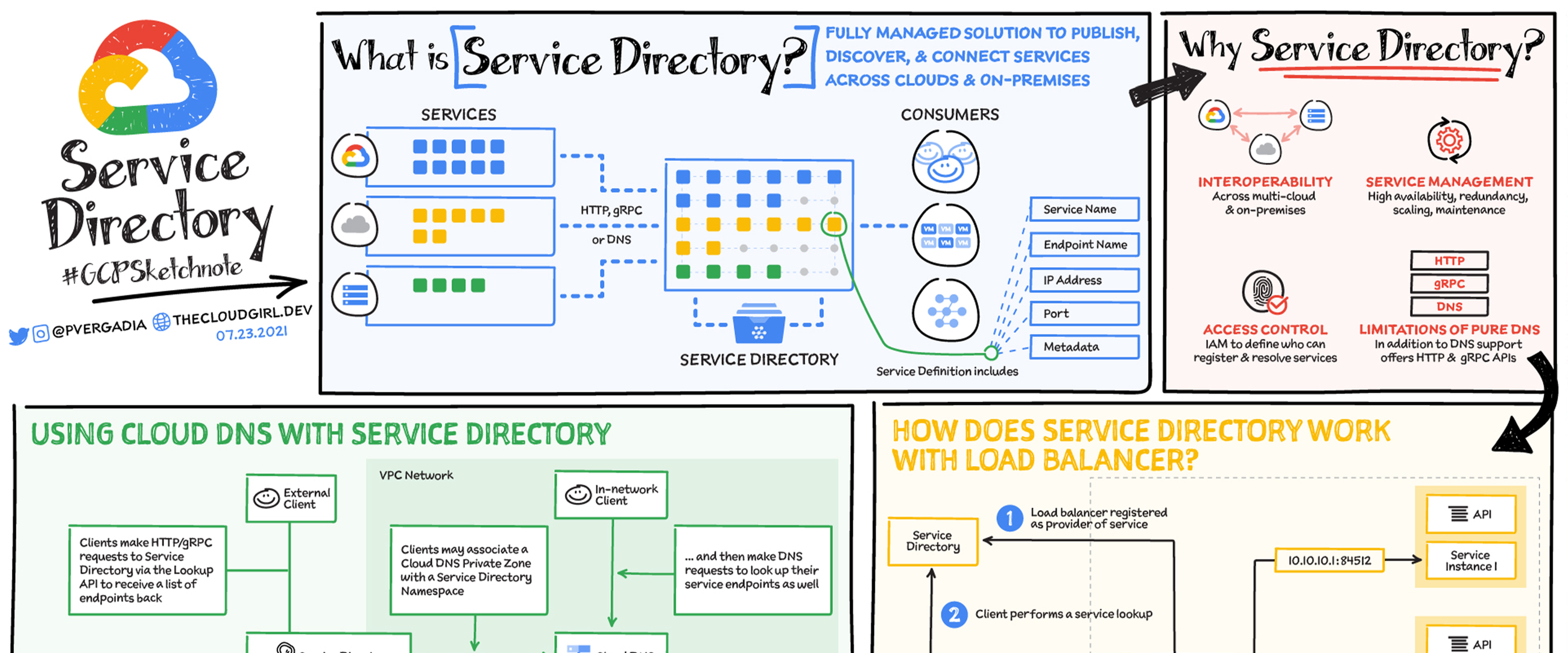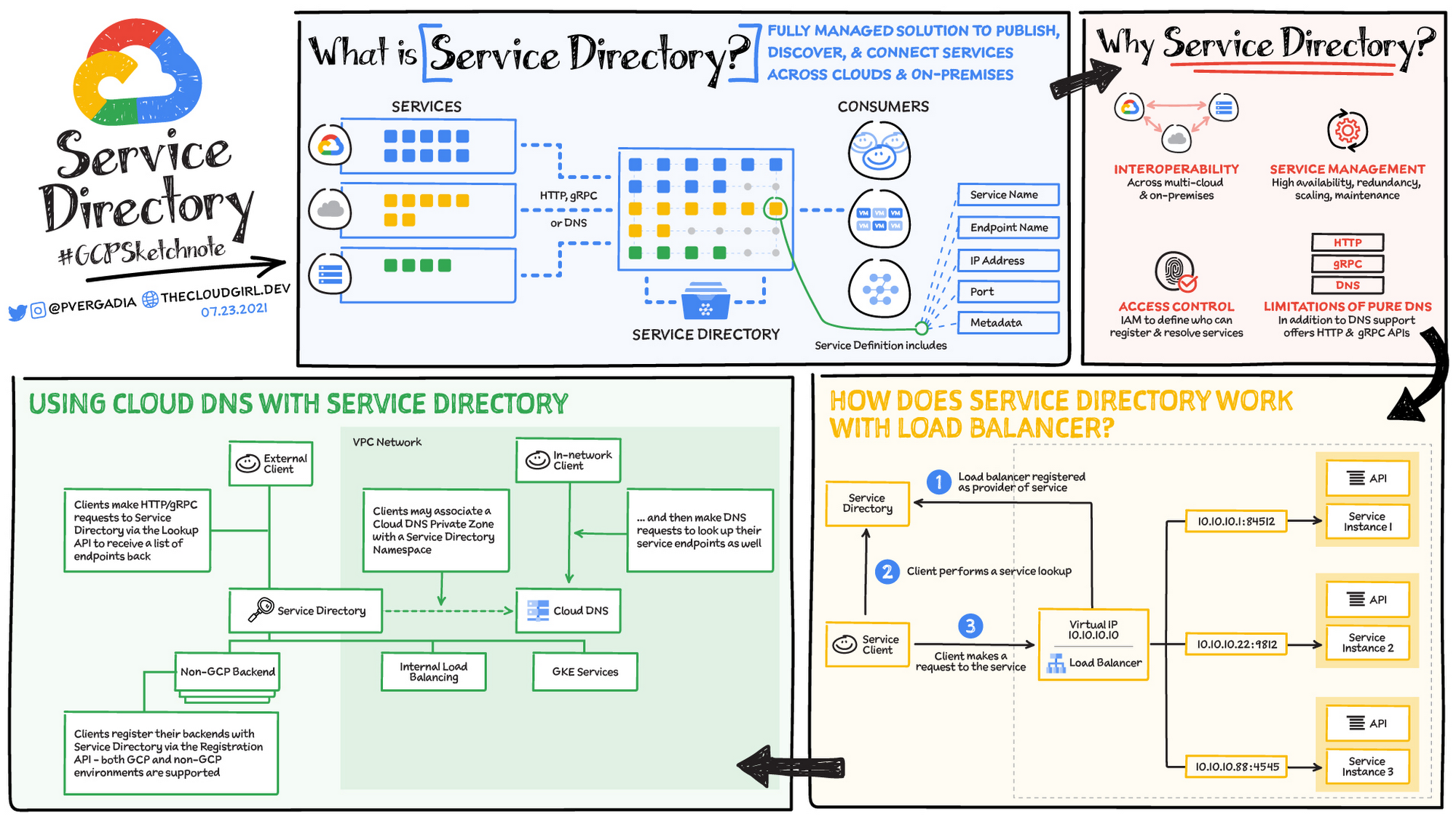Service Directory cheat sheet

Priyanka Vergadia
Staff Developer Advocate, Google Cloud
Try Google Cloud
Start building on Google Cloud with $300 in free credits and 20+ always free products.
Free trialMost enterprises have a large number of heterogeneous services deployed across different clouds and on-premises environments. It is complex to look up, publish, and connect these services, but it is necessary to do so for deployment velocity, security, and scalability. That's where Service Directory comes in!
Service Directory is a fully managed platform for discovering, publishing, and connecting services, regardless of the environment. It provides real-time information about all your services in a single place, enabling you to perform service inventory management at scale, whether you have a few service endpoints or thousands.


Why Service Directory?
Imagine that you are building a simple API and that your code needs to call some other application. When endpoint information remains static, you can hard-code these locations into your code or store them in a small configuration file. However, with microservices and multi-cloud, this problem becomes much harder to handle as instances, services, and environments can all change.
Service Directory solves this! Each service instance is registered with Service Directory, where it is immediately reflected in Domain Name System (DNS) and can be queried by using HTTP/gRPC regardless of its implementation and environment. You can create a universal service name that works across environments, make services available over DNS, and apply access controls to services based on network, project, and IAM roles of service accounts.
Service Directory solves the following problems:
- Interoperability: Service Directory is a universal naming service that works across Google Cloud, multi-cloud, and on-premises. You can migrate services between these environments and still use the same service name to register and resolve endpoints.
- Service management: Service Directory is a managed service. Your organization does not have to worry about the high availability, redundancy, scaling, or maintenance concerns of maintaining your own service registry.
- Access control: With Service Directory, you can control who can register and resolve your services using IAM. Assign Service Directory roles to teams, service accounts, and organizations.
- Limitations of pure DNS: DNS resolvers can be unreliable in terms of respecting TTLs and caching, cannot handle larger record sizes, and do not offer an easy way to serve metadata to users. In addition to DNS support, Service Directory offers HTTP and gRPC APIs to query and resolve services.
How Service Directory works with Load Balancer
Here’s how Service Directory works with Load Balancer:
- In Service Directory, Load Balancer is registered as a provider of each service
- The client performs a service lookup via Service Directory
- Service Directory returns the Load Balancer address
- The client makes a call to the service via Load Balancer.
Using Cloud DNS with Service Directory
Cloud DNS is a fast, scalable, and reliable DNS service running on Google's infrastructure. In addition to public DNS zones, Cloud DNS also provides a managed internal DNS solution for private networks on Google Cloud. Private DNS zones enable you to internally name your virtual machine (VM) instances, load balancers, or other resources. DNS queries for those private DNS zones are restricted to your private networks. Here is how you can use Service Directory zones to make service names available using DNS lookups.
- The endpoints are registered directly with Service Directory using the Service Directory API. This can be done for both Google Cloud and non-Google Cloud services.
- Both external and internal clients can look up those services at: https://servicedirectory.googleapis.com
- To enable DNS requests, create a Service Directory zone in Cloud DNS that is associated with a Service Directory namespace.
- Internal clients can resolve this service via DNS, HTTP, or gRPC. External clients (clients not on the private network) must use HTTP or gRPC to resolve service names.
For a more in-depth look into Service Directory check out this documentation.

For more #GCPSketchnote, follow the GitHub repo. For similar cloud content follow me on Twitter @pvergadia and keep an eye out on thecloudgirl.dev




